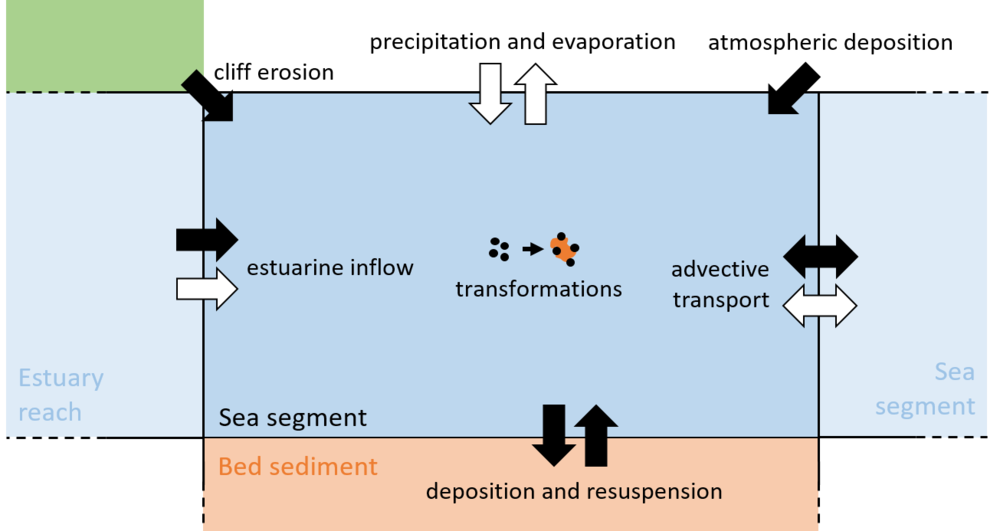Sea model
The final destination for waterborne nanomaterials that have not been deposited to bed sediments is the sea, and the NanoFASE water-soil organism model includes an explicit sea compartment to account for this. The seais simulated as a number of ‘sea segments’, one per grid cell. As with the other aquatic compartments, each sea segment has a bed sediment, which is documented separately. Each segment is linked to its neighbouring environmental compartments, which may include soil (for segments representing the coast), or an estuary reach (for the segment at the mouth of an estuary).

Conceptual model of sea segments and their bed sediments within the NanoFASE water-soil-organism model
A number of processes transfer water, sediment and/or nanomaterials to/from each segment.
- Advection transfers water, suspended sediment and nanomaterials to/from neighbouring sea segments, and into the sea from estuary or river reaches. Advection is driven by mean-depth ocean currents, which are calculated using wind and tidal fields.
- Precipitation and evaporation provides fluxes of water in and out of the sea segments.
- Cliff erosion provides inputs of sediment and heteroaggregated nanomaterials to coastal sea segments.
- Atmospheric deposition transfers nanomaterials into the sea segments.
- Sediment deposition and resuspension transfer SPM and heteroaggregated nanomaterials to/from the bed sediment.
Nanomaterials within each reach can undergo certain transformations, which change their form or state:
- Heteroaggregation to suspended particulate matter (SPM)
- Dissolution
- Chemical alteration, e.g. sulfidation, oxidation
This list of transformations is not exhaustive and the NanoFASE soil–water model provides sufficient flexibility to easily add extra transformation processes. Similarly, the model’s flexibility enables the user to select only those processes relevant to the nanomaterial being modelled.
Read more |
Read also |
|
Visit the NanoFASE Library to read summaries of these reports: |
Tappin, A. D., Burton, J. D., Millward, G. E., & Statham, P. J. (1997). A numerical transport model for predicting the distributions of Cd, Cu, Ni, Pb and Zn in the southern North Sea: the sensitivity of model results to the uncertainties in the magnitudes of metal inputs. Journal of Marine Systems, 13(1-4), 173-204.
|
Contact

Sam Harrison
Centre for Ecology and Hydrology (CEH), UK
